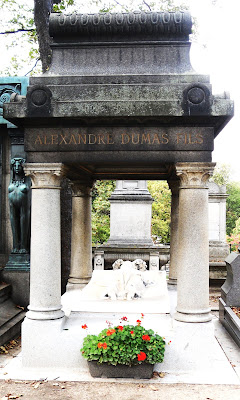'ÉMILE ZOLA
1840—1902
A REPOSÉ ICI DU 5 OCTOBRE 1902
AU 4 JUIN 1908, DATE DE SON TRANSFERT AU PANTHÉON'
[RESTED HERE FROM OCTOBER 1902
TO JUNE 1908, THE DATE OF HIS TRANSFER TO THE PANTHÉON]
Zola died in his Paris home in rue de Bruxelles, 9th arrondissement, on 28 September 1902: the flue had not been drawing properly, and he was poisoned with carbon monoxide. His J'accuse article in L'Aurore had brought him many enemies and although it is possible that there was foul play, nothing was ever proved. His wife Alexandrine survived, and she ensured that Zola's other partner, Jeanne Rozelet, and her two children by Zola — who lived in Verneuil close to the Zolas other home in Médan — were informed of the event.
George Feydeau (1862—1921) was also a dramatist best known for his farces, such as La Dame est chez Maxim (1899) and Occupe-toi d'Amélie (1908).
The family grave of the romantic poet, novelist and playwright Alfred de Vigny (1797—1863).
The Goncourt brothers, both writers, but best known for the establishing of the Académie Goncourt as a result of Edmond's will.
Edmond de Goncourt (1822—96).
Jules de Goncourt (1830—70).
Ary Scheffer (1795—1858) was a painter who frequently took his subjects from literature, notably from the works of Dante, Byron and Goethe. Interestingly, he also did a portrait of Pierre-Jean de Béranger, whose joint tomb with his friend Jacques-Antoine Manuel was featured in my blog post on the Cimetière Père-Lachaise.
Detail of distressed angel over the lintel.
Ernest Renan (1823—92) married Cornélie Henriette Scheffer, Ary Scheffer's niece.
Renan was very interested in science, particularly in Darwin's evolutionary theories. His seven-volume Histoire des origines du christianisme (1863 to 1881) argued that Jesus's life should be considered in the same way as anyone else's, and that the Bible should be subjected to the same critical analysis as any other written work. Unsurprisingly, this caused anger in the Catholic Church.
Alexandre Dumas fils (1824—95), a dramatist and novelist best known for La Dame aux camélias (1852).
The mask of death.
'À
HENRI MEILHAC
AUTEUR DRAMATIQUE
MEMBRE DE L'ACADÉMIE FRANÇAISE
EN TÉMOIGNAGE DE SINCÈRE ADMIRATION
ET D'AFFECTUEUSE GRATITUDE
CE MONUMENT FUT ÉLEVÉ
PAR UN AMI
1900'
Meilhac (1837—97) worked on Offenbach's La Belle Hélène (1865) and La Vie parisienne (1867).
Henri Murger, author of the once very fashionable sentimental novel Scènes de la Vie de Bohème, later adapted into Puccini's La Bohème.
Henri Beyle (Stendhal) (1783—1842), most noted for the novels Le Rouge et le noir (1930) and La Chartreuse de Palme (1939).


























No comments:
Post a Comment